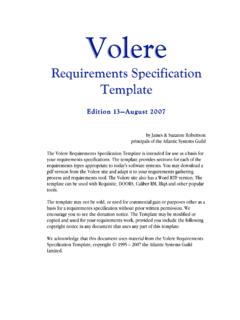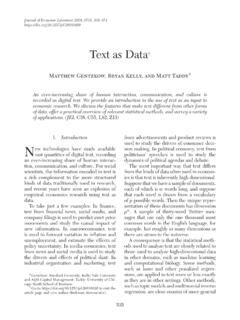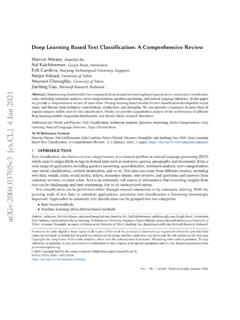Transcription of Sentiment Analysis and Subjectivity
1 1 Sentiment Analysis and Subjectivity Bing Liu Department of Computer Science University of Illinois at Chicago Textual information in the world can be broadly categorized into two main types: facts and opinions. Facts are objective expressions about entities, events and their properties. Opinions are usually subjective expressions that describe people s sentiments, appraisals or feelings toward entities, events and their properties. The concept of opinion is very broad. In this chapter, we only focus on opinion expressions that convey people s positive or negative sentiments.
2 Much of the existing research on textual information processing has been focused on mining and retrieval of factual information, , information retrieval, Web search, text classification, text clustering and many other text mining and natural language processing tasks. Little work had been done on the processing of opinions until only recently. Yet, opinions are so important that whenever we need to make a decision we want to hear others opinions. This is not only true for individuals but also true for organizations. One of the main reasons for the lack of study on opinions is the fact that there was little opinionated text available before the World Wide Web.
3 Before the Web, when an individual needed to make a decision, he/she typically asked for opinions from friends and families. When an organization wanted to find the opinions or sentiments of the general public about its products and services, it conducted opinion polls, surveys, and focus groups. However, with the Web, especially with the explosive growth of the user-generated content on the Web in the past few years, the world has been transformed. The Web has dramatically changed the way that people express their views and opinions.
4 They can now post reviews of products at merchant sites and express their views on almost anything in Internet forums, discussion groups, and blogs, which are collectively called the user-generated content. This online word-of-mouth behavior represents new and measurable sources of information with many practical applications. Now if one wants to buy a product, he/she is no longer limited to asking his/her friends and families because there are many product reviews on the Web which give opinions of existing users of the product. For a company, it may no longer be necessary to conduct surveys, organize focus groups or employ external consultants in order to find consumer opinions about its products and those of its competitors because the user-generated content on the Web can already give them such information.
5 However, finding opinion sources and monitoring them on the Web can still be a formidable task because there are a large number of diverse sources, and each source may also have a huge volume of opinionated text (text with opinions or sentiments). In many cases, opinions are hidden in long forum posts and blogs. It is difficult for a human reader to find relevant sources, extract related sentences with opinions, read them, summarize them, and organize them into usable forms. Thus, automated opinion discovery and summarization systems are needed. Sentiment Analysis , also known as opinion mining , grows out of this need.
6 It is a challenging natural language processing or text mining problem. Due to its tremendous value for practical applications, there has been an explosive growth of both research in academia and applications in the industry. There are now at least 20-30 companies that offer Sentiment Analysis services in USA alone. This chapter introduces this research field. It focuses on the following topics: 1. The problem of Sentiment Analysis : As for any scientific problem, before solving it we need to define or to formalize the problem. The formulation will introduce the basic definitions, core concepts and issues, sub-problems and target objectives.
7 It also serves as a common framework to unify different research directions. From an application point of view, it tells practitioners what the main tasks are, their inputs and outputs, and how the resulting outputs may be used in practice. 2. Sentiment and Subjectivity classification: This is the area that has been researched the most in academia. It treats Sentiment Analysis as a text classification problem. Two sub-topics that have been To appear in Handbook of Natural Language Processing, Second Edition, (editors: N. Indurkhya and F.)
8 J. Damerau), 2010 2 extensively studied are: (1) classifying an opinionated document as expressing a positive or negative opinion, and (2) classifying a sentence or a clause of the sentence as subjective or objective, and for a subjective sentence or clause classifying it as expressing a positive, negative or neutral opinion. The first topic, commonly known as Sentiment classification or document-level Sentiment classification, aims to find the general Sentiment of the author in an opinionated text. For example, given a product review, it determines whether the reviewer is positive or negative about the product.
9 The second topic goes to individual sentences to determine whether a sentence expresses an opinion or not (often called Subjectivity classification), and if so, whether the opinion is positive or negative (called sentence-level Sentiment classification). 3. Feature-based Sentiment Analysis : This model first discovers the targets on which opinions have been expressed in a sentence, and then determines whether the opinions are positive, negative or neutral. The targets are objects, and their components, attributes and features. An object can be a product, service, individual, organization, event, topic, etc.
10 For instance, in a product review sentence, it identifies product features that have been commented on by the reviewer and determines whether the comments are positive or negative. For example, in the sentence, The battery life of this camera is too short, the comment is on battery life of the camera object and the opinion is negative. Many real-life applications require this level of detailed Analysis because in order to make product improvements one needs to know what components and/or features of the product are liked and disliked by consumers. Such information is not discovered by Sentiment and Subjectivity classification.

















